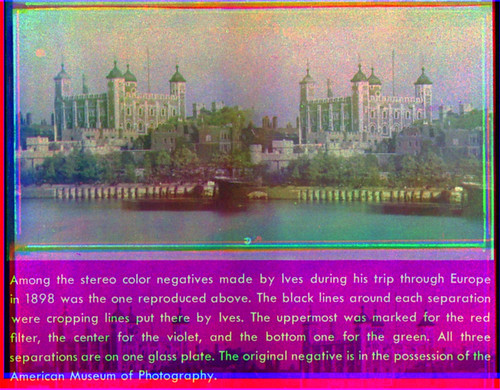Frederick Eugene Ives

|
| 1898 color stereo image image by Frederic Eugene Ives (Image rights) |
Frederic Eugene Ives (1856-1937) was a U.S. inventor and photographer, born in Litchfield, Connecticut.
History
Frederic Ives had no formal education and described himself as an amateur inventor, about whom he remarked, "the typical amateur inventor will pursue his course through any amount of poverty and hardship and indifference, thinking much more about his work than about any material reward which it might bring."[1]
Ives developed an interest in photography and engraving while working as an apprentice and journeyman in the printing business. At the age of 18 he was put in charge of the Cornell University photographic lab between 1874 and 1878. Ives later recalled at a 1928 address to the Optical Society of America that while some professors seemed to think having someone his age in the position was a joke, that he took it very seriously: "I was so much interested in this experimental work that I slept in the laboratory, and worked at all hours, living principally upon crackers and milk. Once, I worked for a period of five days without sleep." It was during this period that Ives invented the half tone process which revolutionized newspaper printing, allowing papers to print reproductions of photographs using paper and ink.[2]
In 1885 he was one of the founding members of the Photographic Society of Philadelphia.[3] He is also know for his pioneering work in color and stereo photographic processes. In 1996 Ives was the subject of a U.S. 32 cent postage stamp celebrating his achievements.
Notable Inventions
While Ives invented or improved many processes and devices important to photography and motion pictures, most were not patented and are not well known because he never profited from them. He did receive at least 90 patents and many of these were on notable inventions:
- Parallax Stereogram - a patented combination of special image processing techniques and special viewing equipment which provided a 3D motion picture experience.
- 3-color Camera and Photochromoscope - In 1892 Ives patented a color camera and then in 1894 patented an improved version of the same camera.
- A Photographic Attachment for Optical Instruments - a patented mechanism for attaching cameras to microscopes, allowing what we know today as photomicrography. [4]
- Binocular Microscope - a patented improvement on the binocular microscope[5]
- Half Tone Letterpress - a patented photographic reproduction process that allows ink printed publication to reproduce photographic images with tonal qualities similar to the original photograph. Half tone printing was developed a few years earlier in other countries as well and eventually became a widely used alternative to the early method of using hand-carved wood engravings that resembled the desired photograph. [6]
Early Color Photography
In 1906, Ives captured color stereo photographs of San Fransisco showing the aftermath of the 1906 earthquake. The photographs were taken use Ives' patented Photochromoscope camera which used subtractive color theory to capture color images. The device took red, green, and blue images through color filters. The three images were bound together into a single slide known as a Krőmgram and viewed in a device Ives named the Krőmscőp. After Ives death in 1937, these early color photographs were stored as part of the Ives collection at the National Museum of American History. The photographs were rediscovered in 2009 by a researcher cataloguing the collection.[7]
References
- ↑ Autobiography of an Amateur Inventor, Frederic Eugene Ives, 1928
- ↑ Frederic Ives honored with US Postage Stamp (archived)
- ↑ The Photographic Society of Philadelphia
- ↑ US Patent 707422 (PDF format)
- ↑ US Patent 739182 (PDF format)
- ↑ US Patent 237664
- ↑ The 1906 San Francisco Earthquake, in color